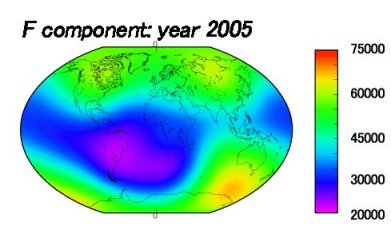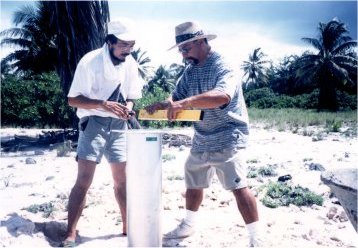Kakioka is one of the world's leading observatories, playing important domestic and international roles in the monitoring of global geomagnetic variations.
(1) Observation records from the Kakioka Magnetic Observatory are provided to relevant organizations worldwide via the World Data Centre (WDC). Since the 1990s, the Intermagnet data exchange platform*1 has been available to relevant organizations to provide observatory data in quasi-real time online. The Japan Meteorological Agency is a member of Intermagnet, with Kakioka, Memambetsu and Kanoya recognized as representative observatories in Japan.
(2) Kakioka, Memambetsu and Kanoya are operated specifically for long-term magnetism monitoring with high precision for the International Geomagnetic Reference Field (IGRF) model *2.
(3) Data from magnetic observation stations are used for space weather forecasting and monitoring/prediction of geomagnetic storm conditions. Kakioka plays a crucial role in the international monitoring network as one of world's four stations designated for Dst index (representing the degree of geomagnetic disturbance caused by the Earth's ring current). Memambetsu is among 12 stations providing geomagnetic activity index for the Northern Hemisphere (Kn), and Kanoya is one of 10 stations providing data for the determination of magnetic storm sudden commencement.
(*1)
Backed by the International Association of Geomagnetism and Aeronomy (IAGA), Intermagnet is supported by geomagnetic observers worldwide. With the aim of accurately monitoring global geomagnetic variations, standards for magnetic observation have been defined and digital data from Intermagnet observatories conforming to the standard are distributed in quasi-real time. Definitive data are also published annually online.
(*2)
Long-term, stable and precise observation is indispensable for monitoring the status of global geomagnetic fields, along with a global observation network. Precise observation data from ground-based magnetic stations worldwide and satellite observations are used to produce an IGRF model every five years to represent the average distribution and temporal variation of geomagnetic fields. The model is widely used as a standard for determining geomagnetic fields at any given time and place.

Various international cooperation programmes are pursued to elucidate the Earth's environment and make advancements in the field of geophysics. The Kakioka Magnetic Observatory actively participates in such projects, with previous significant contributions including:

Technical cooperation on geomagnetic observation in Antarctica, Micronesia, Korea and other locations is provided. In 2004, a workshop of the International Association of Geomagnetism and Aeronomy (IAGA) was held at Kakioka, which remains available for future hosting opportunities.


Copyright (c) Kakioka Magnetic Observatory, Japan Meteorological Agency. All rights reserved.
